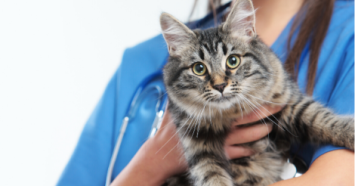
Toxoplasmosis is a feline parasite caused by the coccidian protozoan Toxoplasma gondii. Protozoans are a different kind of infectious organism from bacteria or viruses. Toxoplasma organisms are single-celled parasites that are similar to ameba.
Toxoplasmosis Transmission
Microscopic Toxoplasma gondii eggs are passed from an infected cat within their feces. It takes 1-5 days for the eggs to become infectious once in the environment. Animals become infected when they eat infected eggs or infected animals. Usually, this occurs from eating or drinking contaminated food, water, or soil. Eggs hatch once they reach the intestines. The protozoans can then travel to various areas inside the body, including the muscles, heart, internal organs, and brain. Toxoplasma parasites inhabit these areas inside cysts, or microscopic capsules attached to host (i.e. infected animal) tissues, continuing to multiply. Cysts burst once enough protozoans have been produced, allowing for further replication and growth.
Toxoplasmosis Symptoms in Cats
The host’s immune system reacts strongly to cysts, especially when they rupture and release new protozoan organisms. Inflammation is common. Usually the symptoms will depend on where the cysts occur. The following symptoms have been reported with toxoplasmosis infections:
Fever
Lethargy or laying around more
Trouble breathing
Muscle pain
Decreased mobility or trouble walking
Paralysis
Localized pain when touching the abdomen
Blindness
Swelling or oozing from the skin
Seizures
Some cats will not show any symptoms of toxoplasmosis. These cats are carriers of infection, producing eggs without experiencing actual disease.
Diagnosing Toxoplasmosis
Toxoplasmosis can be difficult to diagnose in cats because of their potential to be carriers. Microscopic examination of a fecal sample will sometimes show Toxoplasma eggs. Certain laboratory tests can be performed to test for Toxoplasma gondii in the blood and tissues. These tests should be used in combination with a physical examination performed by a veterinarian and the cat’s symptoms in order to make an accurate diagnosis. Other laboratory tests may also be necessary to assess how the cat’s internal organs are functioning (e.g. CBC, biochemistry panel, urinalysis).
Toxoplasmosis Treatment and Prevention
Treating toxoplasmosis in cats can be frustrating. No medications are available that can completely clear Toxoplasma organisms from the body. Cysts can remain in the tissues for life. Certain medications can be used to remove the protozoans from the bloodstream and control the symptoms. Treatment can take weeks.
No vaccines are available to prevent toxoplasmosis. Remove any feces in the area as soon as possible. Prevent pets from preying on and eating small animals that may be infected. Do not feed fresh raw or frozen raw meat to pets.
Toxoplasmosis and Pregnancy
All warm-blooded species can be infected with toxoplasmosis, including humans. Only cats will shed eggs. Most animals and humans have strong enough immune systems to prevent toxoplasmosis infection from occurring; however, young children, immunocompromised people (e.g. AIDS patients, cancer patients, people on immunosuppressive medications) are more susceptible to infection. Of further concern, if a woman becomes infected during pregnancy, the fetus is at risk for developing blindness, brain or eye damage, and mental disabilities.
People at high risk for infection should wear gloves when gardening. Because of the roughly 24 hour window before eggs in the environment become infectious, cat feces should be removed at least once daily. Ensure all meat is fully cooked and thoroughly wash fruits and vegetables.